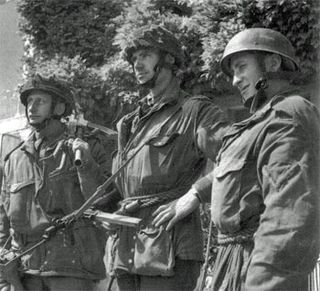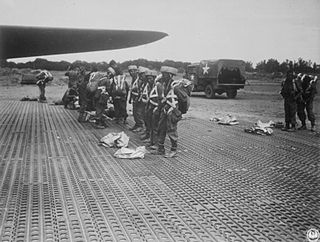
The Chindits, officially known as Long Range Penetration Groups, were special operations units of the British and Indian armies which saw action in 1943–1944 during the Burma Campaign of World War II.

The 1st Airborne Division was an airborne infantry division of the British Army during the Second World War. The division was formed in late 1941 during the Second World War, after the British Prime Minister, Winston Churchill, demanded an airborne force, and was initially under command of Major-General Frederick A. M. "Boy" Browning. The division was one of two airborne divisions raised by the British Army during the war, with the other being the 6th Airborne Division, created in May 1943, using former units of the 1st Airborne Division.

The 6th Airborne Division was an airborne infantry division of the British Army during the Second World War. Despite its name, the 6th was actually the second of two airborne divisions raised by the British Army during the war, the other being the 1st Airborne Division. The 6th Airborne Division was formed in the Second World War, in mid-1943, and was commanded by Major-General Richard N. Gale. The division consisted of the 3rd and 5th Parachute Brigades along with the 6th Airlanding Brigade and supporting units.

The Indian Army during World War II, a British force also referred to as the British Indian Army, began the war, in 1939, numbering just under 200,000 men. By the end of the war, it had become the largest volunteer army in history, rising to over 2.5 million men in August 1945. Serving in divisions of infantry, armour and a fledgling airborne force, they fought on three continents in Africa, Europe and Asia.
The 77th Indian Infantry Brigade was an infantry brigade formation of the Indian Army during World War II. It was formed in India in June 1942. The brigade was assigned to the Chindits and organised into eight columns for operations behind enemy lines in Burma. In March 1945, it was converted into the 77th Indian Parachute Brigade and assigned to the 44th Airborne Division.

The Parachute Regiment is an airborne and special forces regiment of the Indian Army. It was raised in 1945 as part of the British Indian Army but was disbanded after World War II and was re-raised in 1952 as part of the Indian Army. Currently it consists of fifteen Special Forces, two Territorial Army and one Rashtriya Rifles battalions.
The Order of battle of the Chindits, an Allied special force which carried out two deep penetration raids behind Japanese line during the Burma campaign in the South-East Asian Theatre of World War II

The 17th Infantry Division is a formation of the Indian Army. During the Second World War, it had the distinction of being continually in combat during the three-year-long Burma Campaign. The division was re-raised in 1960 and the 17 Mountain Division is presently located in Sikkim under XXXIII Corps.

The 5th Infantry Brigade was a regular infantry brigade of the British Army that was in existence since before the First World War, except for a short break in the late 1970s. It was an Airborne Brigade from the early 1980s until amalgamating with 24th Airmobile Brigade, in 1999, to form 16 Air Assault Brigade.

The 5th Parachute Brigade was an airborne forces formation of brigade strength, raised by the British Army during the Second World War. Created during 1943, the brigade was assigned to the 6th Airborne Division, serving alongside the 3rd Parachute Brigade and the 6th Airlanding Brigade.

The 7th Infantry Division is a war-formed infantry division, part of the British Indian Army that saw service in the Burma Campaign.

The 2nd Parachute Brigade was an airborne forces brigade formed by the British Army during the Second World War.

The 23rd Indian Infantry Division was an infantry division of the Indian Army during World War II. It fought in the Burma Campaign. It was then reformed as a division of the independent Indian Army in 1959.

The 26th Indian Infantry Division, was an infantry division of the Indian Army during World War II. It fought in the Burma Campaign.

The 25th Indian Infantry Division was an infantry division of the Indian Army during World War II which fought in the Burma Campaign. It was re-raised within the post-independence Indian Army in 1948.

The 6th Airlanding Brigade was an airborne infantry brigade of the British Army during the Second World War. Created during May 1943, the brigade was composed of three glider infantry battalions and supporting units, and was assigned to the 6th Airborne Division, alongside the 3rd and 5th Parachute Brigades.

The 50th Parachute Brigade is a brigade-sized formation of the Indian Army. Its main force is formed of battalions of the Parachute Regiment. It consists of 3 Parachute Regiment battalions, supported by units of the Regiment of Artillery, the Corps of Engineers and the Army Medical Corps

The Battle of Elephant Point was an airborne operation at the mouth of the Rangoon River conducted by a composite Gurkha airborne battalion that took place on 1 May 1945. In March 1945, plans were made for an assault on Rangoon, the capital of Burma, as a stepping-stone on the way to recapturing Malaya and Singapore. Initial plans for the assault on the city had called for a purely land-based approach by British Fourteenth Army, but concerns about heavy Japanese resistance led to this being modified with the addition of a joint amphibious-airborne assault. This assault, led by 26th Indian Division, would sail up the Rangoon River, but before it could do so, the river would have to be cleared of Japanese and British mines. In order to achieve this, coastal defences along the river would have to be neutralized, including a battery at Elephant Point.

The 15th Parachute Battalion was an airborne infantry battalion of the Parachute Regiment, originally raised as 15th (King's) Parachute Battalion by the British Army in World War II.

The 16th (Staffords) Parachute Battalion was an airborne infantry battalion of the Parachute Regiment, raised by the British Army in World War II.

















